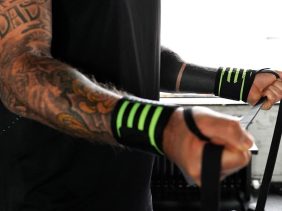Do I Need a Weightlifting Belt?
 © foodspring
© foodspring
You’re at the gym. You’ve finished warming up and are getting ready for the first exercise of the session. All set to punish your muscles and make yourself so big it’s hard to walk through the door on your way out. You put on your headphones and play your “Ultimate Killer Workout” playlist. You choose the right weight, take a sip of water, take a deep breath and… Damn it! Yes, there they are. Next to the mirrors, in the rack area. The strongest guys in the gym doing deadlifts. Those mystical beings that are built like XXL-sized industrial refrigerators and make you feel as if you have trouble carrying dumbbells weighing more than 2 kg.
But what’s the secret of these people who look like updated versions of Ronnie Coleman himself? You stare them up and down to see if you can figure out what it takes to achieve such a sculpted body until, at last, you realize that they’re all wearing a weightlifting belt. That’s it! That must be it. A lumbar belt is what will give you that extra power for a physique you couldn’t achieve in a lifetime of training.
There’s no point denying it. Bodybuilding belts are cool. They create a special feeling that makes people think that they have magical powers. The one who wears a belt controls the gym, knows how to train and enjoys a physical supremacy rarely known previously. The undisputed leader of the pack. The king of discs and dumbbells. Now then, you, just another mortal on the face of the earth, should you wear a gym belt regardless of the training you’re going to do? What are the benefits? How can you get the most out of it?
When is it best to use a weightlifting belt?
If you watch a weightlifting competition, you’ll notice that the athletes wear a uniform that never fails: stiff-soled shoes, a weightlifting jersey and belt. A large, very wide belt.
Some of these belts are made of stiff nylon, others of natural or synthetic leather. Regardless of the material, they all have one objective: to increase the intra-abdominal pressure of athletes to provide extra support to the spine when lifting very heavy loads.
In terms of size, they’re available in one size with adjustable waistband or Velcro. Both options are equally safe. You can also find some brands with different sizes in their belts. In any case, if you choose the wrong size, it’s best to change it as soon as possible. The wrong size can lead to injury and discomfort.
Gym belts are, above all, safety features. When used correctly, they serve their purpose as several research studies have shown. For example, this clinical trial monitored and analyzed several subjects performing dead weight exercises with and without a belt to conclude that belt use helped increase abdominal pressure. This, in turn, resulted in a reduction of the impact on the vertebral discs, improving the physical safety of the subjects analyzed. A study published in Medicine & Science in Sports & Exercise examined 5 subjects performing different heavy exercises with and without a belt. The result is very similar to the previous research: “the belt helps support the trunk and increases intra-abdominal pressure”.
It’s clear that the belt helps to stabilize the trunk when we lift weights so that, thanks to the pressure on the abdominal area, it helps us to transmit the force in a more efficient way. In other words, it can help you get some extra reps or move the weight up a bit. As you can see, the science focuses on the use of the belt in exercises where the pressure is centered on the core. That’s why you see people in your gym using the belt when doing squats or deadlifts.
If you’re not doing any of these exercises, a belt won’t do much for you beyond being a cool addition to your outfit. Maybe you can join the group of muscular Adonises at the gym. But little else. Plus, the research suggests that while wearing a belt may increase lower back stability when lifting, repeated use may decrease core muscle engagement, increasing the risk of injury when lifting without the support.
Learn more about this topic at foodspring:
- 5 great tricks for falling asleep straight away
- Why is getting a good nights sleep more important than the number of hours you sleep?
- How to get a good night’s sleep: 8 tips for starting your day off right
Sources for this article
We at foodspring use only high-quality sources, including peer-reviewed studies, to support the facts within our articles. Read our editorial policy to learn more about how we fact-check and keep our content accurate, reliable, and trustworthy.





























